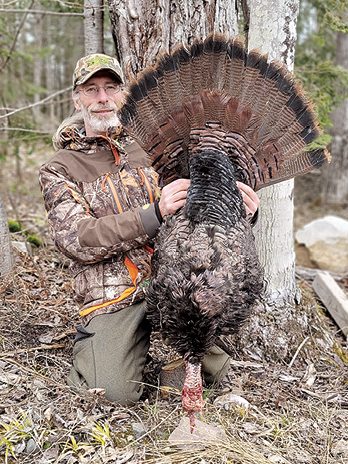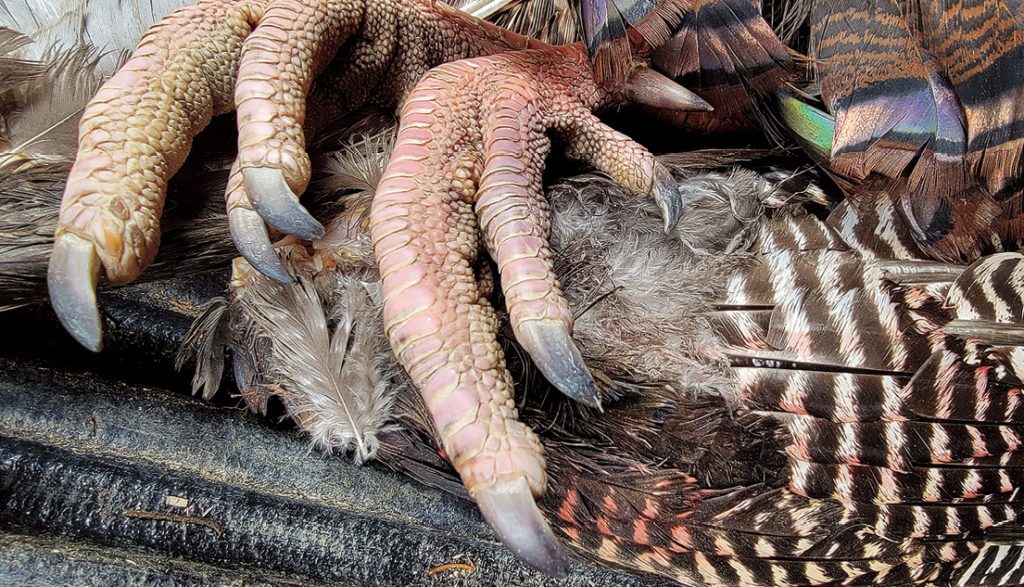It was about 45 minutes into the first hour of the turkey hunt when I spotted the bird. It was a gobbler, slinking along the edge of the field. It stopped and loudly gobbled, but was about 100 yards away, well out of range of my shotgun. Then another bird appeared, a jake (young gobbler) with a shorter beard. Behind them were some hens who were tagging along.
I was in a ground blind and could not see very well to my right or left. There was a jake and hen turkey decoy placed in front of me at about 20 yards. I clucked like a hen with my box call, but the gobbler and his friends kept moving away. I got out the binoculars to watch them. As this was happening, I suddenly noticed movement to the right. A jake appeared, briskly walking toward the decoy. Then another jake appeared, followed by a third. I always prefer to shoot mature gobblers, but I also like to eat wild turkey—a jake was going to be just fine. All three were clustered around the decoy, trying to beat it up. I laid the bead on the closest jake, and as the other two moved away, I pulled the trigger. The bird went down and the other jakes ran off. After a short pause of thanks, I collected my turkey. It was a nice bird of about 17 pounds and would make great eating. It had been a memorable morning.
Wild turkey hunting is not available in northwestern Ontario. However, northeastern Ontario, particularly around Sault Ste. Marie, now has a huntable population of wild turkey thanks to an introduction by the Ontario Ministry of Natural Resources. There are also tens of thousands of wild turkeys in southern Ontario, which is where the majority of northern Ontario hunters travel. You can also turkey hunt in southern Minnesota, Wisconsin and Michigan, but you will need to look at the regulations and understand the licensing and hunting validation systems each state uses.
If you are new to turkey hunting or want to get into it, I have some basic advice to offer.
Get Good Camouflage Clothing
Don’t scrimp here. Get a camouflage suit that matches your surroundings, is quiet when you walk and is waterproof. You will need pants, a jacket, a face mask and gloves, minimum. You cannot have any colour on your cap or clothing, especially no red or blue. This is for safety reasons, as gobblers have these colours on their head. Buy waterproof camo boots that you can walk and sit in. I prefer knee high rubber boots as many fields are wet in the spring. Also, invest in a Thermacell as ticks and other biting bugs can be bad in the turkey woods.
Get a Turkey Call and Practice
I don’t care whether you want to mouth call, box call or use a slate; just take the time to learn how to call a turkey before you get in the field. A few hours listening to callers on YouTube will help immensely. Also, I’d highly recommend investing in a high-quality hen or jake decoy, or both. Get the most realistic one you can afford—it will make a difference.

Shoot Your Gun
Make sure you have a good tight pattern when you shoot your shotgun. Use a turkey head target and shoot at 10, 20 and 30 yards. Buy a good quality turkey load and stick with it.
Be Patient
Turkey hunting demands patience. It also requires the hunter to be still, especially when sitting on the ground. There are no tree stands allowed in turkey hunting. Most hunters sit in the open along a field line at the base of a large tree. This often means three or four hours on a thin cushion, moving as little as possible. That’s not so difficult on the first day of the hunt. Give it a few days, however, and your backside starts to feel raw. Consider carefully where you place your bum, as discomfort can take many forms. I have become very fond of hunting turkeys in ground blinds; they will keep you out of the wind and rain and allow you to sit on an actual seat. You can also move a bit more than you can on the ground, but not much. You will not fool a gobbler if he sees anything amiss; he will turn and run. With that in mind…
Keep the Phone in Your Pocket
If you are sitting on the ground, in camouflage, trying to be still, using your phone will be a problem. A frequent turkey hunting partner of mine was very good at ignoring his phone; he was usually focused when he was turkey hunting. Yet on the last day of a long hunt, my friend slipped up.
It started when he made a long trek around a hardwood to intercept a gobbler. He was super eager to fill at least one turkey tag. He circled around the bush and sure enough, a gobbler was coming his way. He set up and waited. Yet the plan was foiled when the gobbler snuck up behind him and caught movement. There was some flapping of wings and that was it. Dejected and sweating, my friend put down his shotgun and began to text me his unlucky story. As he typed out the tale, he noticed movement. Another gobbler had snuck in and seen him move—he’d been busted yet again. My friend did not fill that turkey tag. His last text said, “I feel ill.”
A smartphone is handy, but keep it in your pocket more than in your hand.
Keep your movements small and your wits sharp, and you could bag a wild turkey this spring.

